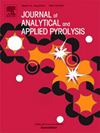
JOURNAL OF ANALYTICAL AND APPLIED PYROLYSIS
分析與應(yīng)用熱解雜志
- 期刊周期:Bimonthly
- 研究方向:化學(xué)
- 影響因子:3.47
- 通訊地址:ELSEVIER SCIENCE BV, PO BOX 211, AMSTERDAM, NETHERLANDS, 1000 AE
- 官網(wǎng):http://www.elsevier.com/wps/find/journaldescription.cws_home/502687/description#description
- 投稿地址:http://ees.elsevier.com/jaap/
- 審稿速度:約3.0個(gè)月
中文簡介
《分析與應(yīng)用熱分解雜志》(JAAP)致力于發(fā)表有關(guān)熱分解過程創(chuàng)新應(yīng)用、與熱分解反應(yīng)有關(guān)的產(chǎn)物的表征以及反應(yīng)機(jī)理研究的論文。JAAP認(rèn)為,手稿應(yīng)該在這些主題上有重大進(jìn)展。在求職信中必須令人滿意地論證這種新穎性。如果給編輯的一份手稿附有附信,而沒有說明新穎性,則很可能會(huì)在未經(jīng)審查的情況下被拒絕。更具體地說,日記的范圍包括:化學(xué)物質(zhì)和材料的基本熱解研究,包括:-熱分解反應(yīng)的實(shí)驗(yàn)研究,如化學(xué)機(jī)理和動(dòng)力學(xué)研究;這包括制備新化合物的熱分解方法和高溫反應(yīng)機(jī)理;-對(duì)反應(yīng)機(jī)理、動(dòng)力學(xué)和熱力學(xué)的計(jì)算和理論研究是可以接受的,前提是它們與實(shí)驗(yàn)數(shù)據(jù)直接相關(guān),無論是新的還是以前出版的,但它們必須在論文中充分描述;-熱解數(shù)據(jù)的計(jì)算處理,如高級(jí)模式識(shí)別、主成分分析等多元分析。分析性熱解,即通過熱誘導(dǎo)降解反應(yīng)在惰性氣氛中表征材料;-通過揭示熱分解反應(yīng)和化學(xué)分解反應(yīng)來探索材料的化學(xué)成分和結(jié)構(gòu),從而得到通過化學(xué)和光譜方法完全識(shí)別的產(chǎn)品;-分析熱分解在環(huán)境、生物、醫(yī)學(xué)、法醫(yī)、文化遺產(chǎn)、食品、地球化學(xué)、聚合物和材料科學(xué)中的應(yīng)用;-使用新儀器和新的分析方法,利用熱分解反應(yīng)或分解熱分解產(chǎn)物的化學(xué)成分。應(yīng)用熱分解處理熱分解過程的發(fā)展,用于從化石或可再生原料或廢物中生產(chǎn)有價(jià)值的化學(xué)品和/或能源載體(氣體、液體、固體或電力)和/或材料、材料的回收和有毒物質(zhì)的處置。手稿必須討論熱解條件與產(chǎn)品特性之間的關(guān)系。本主題包括:-各種原料(化石燃料、生物質(zhì)、廢棄物、聚合物等)及不同原料的共加工;-各種熱過程(慢速和快速熱分解、高溫分解、碳化、高壓熱分解、催化熱分解、脫氧、加氫熱分解、溶劑液化)。只有當(dāng)手稿的主要焦點(diǎn)是熱分解過程時(shí),熱分解過程與其他類型的處理(機(jī)械、生物或化學(xué))或材料特性的組合才在期刊的范圍內(nèi)。研究了不同的熱分解條件,采用熱分解反應(yīng)器和產(chǎn)品凈化相結(jié)合的綜合工藝是可行的。熱分解反應(yīng)器或過程的計(jì)算模型應(yīng)與新的或以前發(fā)布的實(shí)驗(yàn)數(shù)據(jù)相關(guān),但本文必須對(duì)這些數(shù)據(jù)進(jìn)行充分的描述。應(yīng)徹底描述熱解條件(固體和蒸汽的停留時(shí)間、溫度分布等)。熱解產(chǎn)物必須具有化學(xué)特征。催化劑應(yīng)在反應(yīng)前進(jìn)行物理和化學(xué)性質(zhì)的表征,并在可行的情況下,對(duì)反應(yīng)后的催化劑進(jìn)行分析也是可取的。雖然這并非總是可能的,但至少應(yīng)進(jìn)行定性評(píng)估。用常規(guī)方法研究一種新原料或材料的熱分解,但沒有新的熱分解過程的發(fā)展,這還不足以被日本航空航天局所考慮。評(píng)論文章由編輯邀請(qǐng),但也可以書面形式提交給評(píng)論編輯。評(píng)論文章的主題應(yīng)該足夠廣泛,以吸引廣大讀者。討論應(yīng)該簡潔,但要充分。在某些情況下,更詳細(xì)的討論可能是適當(dāng)?shù)摹nA(yù)計(jì)評(píng)論應(yīng)該是關(guān)鍵的,而不僅僅是已發(fā)布數(shù)據(jù)的目錄。它們應(yīng)該包括該主題最重要的最新進(jìn)展,而科學(xué)意義較低的論文應(yīng)該被給予非常有限的覆蓋。超出JAAP范圍該雜志不考慮基于以下內(nèi)容的研究:-活性炭的活化及活性炭的表征;-熱分析、未用化學(xué)和光譜法表征熱解產(chǎn)物的質(zhì)量產(chǎn)率;-熱分解產(chǎn)物的表征和應(yīng)用,除非與了解熱分解過程和條件的影響/細(xì)節(jié)有明確的關(guān)聯(lián)/目的;-沒有實(shí)驗(yàn)數(shù)據(jù)補(bǔ)充或驗(yàn)證的理論研究、動(dòng)力學(xué)模型等;-燃燒、氣化或焚燒,除非與熱解和氧化反應(yīng)之間的相互作用特別相關(guān)。
英文簡介
The Journal of Analytical and Applied Pyrolysis (JAAP) is devoted to the publication of papers dealing with innovative applications of pyrolysis processes, the characterization of products related to pyrolysis reactions, and investigations of reaction mechanism. To be considered by JAAP, a manuscript should present significant progress in these topics. The novelty must be satisfactorily argued in the cover letter. A manuscript with a cover letter to the editor not addressing the novelty is likely to be rejected without review.More specifically, the Scope of the Journal includes:Fundamental pyrolysis research on chemical substances and materials comprising: - experimental studies of pyrolysis reactions such as chemical mechanism and kinetic investigations; this includes preparative pyrolysis methods for the synthesis of novel compounds and mechanisms of high temperature reactions;- computational and theoretical studies of reaction mechanism, kinetics, and thermodynamics are acceptable, provided they are directly related to experimental data, either new or previously published, but they must be described adequately in the paper;- computational processing of pyrolysis data, such as advanced pattern recognition and principal component analysis and other multivariate analyses.Analytical pyrolysis, i.e. the characterization of a material in inert atmosphere by thermally induced degradation reactions;- exploring chemical composition and structure of materials by revealing thermal and chemical decomposition reactions leading to products fully identified by chemical and spectroscopic methods;- applications of analytical pyrolysis in environmental, biological, medical, forensic, cultural heritage, food, geochemical, polymer, and materials science;- new instrumentation and new analytical methods using pyrolysis reactions or to unravel the chemical composition of pyrolysis products.Applied pyrolysis dealing with the development of pyrolysis processes for producing valuable chemicals and/or energy carriers (gas, liquid, solid or electricity) and/or materials from fossil or renewable feedstock or waste, the recycling of materials, and the disposal of toxic substances. The manuscript must discuss the relationships between pyrolysis conditions and product characteristics. This topic includes:- various feedstock (fossil fuels, biomass, wastes, polymers, etc.) and the co-processing of different feedstock;- various thermal processes (slow and fast pyrolysis, torrefaction, carbonization, high pressure pyrolysis, catalytic pyrolysis, deoxygenation, hydropyrolysis, solvent liquefaction).The combination of a pyrolysis process with other types of treatment (mechanical, biological, or chemical) or materials characterization is within the scope of the journal only if the main focus of the manuscript is the pyrolysis process. Integrated processes combining pyrolysis reactors and products purification are welcome, if different pyrolysis conditions are studied. The computational modeling of pyrolysis reactors or processes should be related to experimental data, either new or previously published, but they must be described adequately in the paper.The pyrolysis conditions should be described thoroughly (residence times of solid and vapors, temperature distributions, etc.). The pyrolysis products must be chemically characterized. Catalysts should be physically and chemically characterized before reaction, and, when feasible analysis of catalysts after reaction is also desirable. While this may not always be possible, at least qualitative assessments should be made.The investigation of pyrolysis of a new feedstock or material with conventional methods, but without new development of the pyrolysis process is not sufficiently novel to be considered by JAAP.Review articles are invited by the Editors but may also be proposed in writing to the Review Editor. The subject of review articles should be broad enough to appeal to a wide range of readers. Discussion should be concise, but adequate. More detailed discussion may be appropriate in some cases. It is expected that reviews should be critical rather than just catalogs of published data. They should include the most important, recent advances in the topic, whereas papers of low scientific significance should be given very limited coverage.Out of the scope of JAAPThe Journal does not consider studies based on:- the activation of carbons and characterization of activated carbons;- thermal analysis, mass yields without characterization of the pyrolysis products by chemical and spectroscopic methods;- characterization and application of pyrolysis products, unless clearly related to/aimed at understanding the influence/details of pyrolysis processes and conditions;- theoretical studies, kinetic modelling etc. which are not complemented with or validated by experimental data- combustion, gasification or incineration unless specifically related to the interplay between pyrolysis and oxidation reactions.
近年期刊影響因子趨勢圖
相關(guān)化學(xué)SCI期刊推薦
- SemimonthlyCHEMISTRY-A EUROPEAN JOURNAL
- WeeklyJOURNAL OF THE AMERICAN CHEMICAL SOCIETY
- MonthlyINTERNATIONAL JOURNAL OF MOLECULAR SCIENCES
- SemimonthlyORGANIC & BIOMOLECULAR CHEMISTRY
- SemimonthlyCOLLOIDS AND SURFACES A-PHYSICOCHEMICAL AND ENGINEERING ASPECTS
- SemimonthlyADVANCED SYNTHESIS & CATALYSIS
- SemimonthlyANALYTICAL AND BIOANALYTICAL CHEMISTRY
- ACS Catalysis
- WeeklyPHYSICAL CHEMISTRY CHEMICAL PHYSICS
- BiweeklyORGANIC LETTERS
SCI期刊欄目
SCI期刊 工程技術(shù) 物理 生物 化學(xué) 醫(yī)學(xué) 農(nóng)林科學(xué) 數(shù)學(xué) 地學(xué)天文 地學(xué) 環(huán)境科學(xué)與生態(tài)學(xué) 綜合性期刊 管理科學(xué) 社會(huì)科學(xué)
期刊論文百科問答
- 攝影藝術(shù)領(lǐng)域AHCI期刊推薦《Photography And Culture》
- Nature旗下多學(xué)科子刊Nature Communications
- 中小學(xué)教師值得了解,這些教育學(xué)期刊發(fā)論文容易被人大復(fù)印轉(zhuǎn)載
- 2025年寫管理學(xué)論文可以用的19個(gè)選題
- 測繪領(lǐng)域科技核心期刊選擇 輕松拿捏
- 及時(shí)開論文檢索證明很重要
- 中國水產(chǎn)科學(xué)期刊是核心期刊嗎
- 國際出書需要了解的問題解答
- 合著出書能否評(píng)職稱?
- 電信學(xué)有哪些可投稿的SCI期刊,值得關(guān)注!
